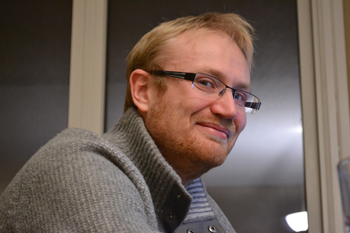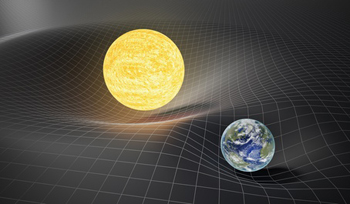The mathematician GH Hardy famously prided himself on the fact that pure mathematics is a means to its own end, without any application whatsoever to the real world. "The 'real' math of the 'real' mathematicians, the mathematics of Fermat and Euler and Gauss and Abel and Riemann, is almost wholly 'useless'," he wrote in his 1940 essay A mathematician's apology.

Claude Warnick.
Indeed, to modern eyes the boundary between pure mathematics on the one hand and applied mathematics on the other can seem like a rigid line. Many mathematicians place themselves firmly into one of the two camps, maths and physics (an important area of applications of maths) are taught as separate subjects in schools and universities, and their textbooks sit in different parts of the library. Are there still mathematicians that do pure maths and think about applications in equal measure?
The answer is yes. We recently had the pleasure of meeting Claude Warnick, employed jointly by the pure maths department and the applied maths and theoretical physics department at the University of Cambridge.
Warnick is interested in a topic that genuinely belongs to both pure maths and physics at the same time. "I work on partial differential equations and general relativity," he explains. "Partial differential equations describe how a physical quantity varies depending on two or more continuous quantities. General relativity is our theory to describe [the force of gravity]."
The link between the two rests on a phenomenon we're all familiar with: waves. "The fact that you can hear me is down to the fact that sound waves are propagating through the air in this room," says Warnick. Waves, including sound waves, can be described by partial differential equations, and it's these wave equations that Warnick is interested in. "One of the most interesting things about [general relativity] is that [its central equation] is very similar in character to the wave equation that describes sound," he explains. The equivalent of sound waves moving through air are gravitational waves. First predicted by Einstein around a 100 years ago, these waves are ripples in the fabric of spacetime that originate from gravitational events, such as the collisions of massive black holes. The detection of gravitational waves in 2015 was one of the major breakthroughs in modern physics.

General relativity asserts that massive objects curve the fabric of spacetime. To formulate it Einstein used geometric notions of curvature developed by Riemann in the 19th century.
"My research [explores] the kind of equations that link these phenomena: wave equations and also problems to do with gravity and general relativity," says Warnick. "The kind of work I am interested in naturally has aspects that are pure mathematical. [In] the study of partial differential equations one has to do a fair amount of analysis and one wants to prove rigorous theorems where possible. On the other hand [what we] are interested in are questions like how black holes behave or how gravitational radiation propagates through the Universe. These are very physical questions, so it's very natural to have a foot in both camps."
In fact, ideas often flow from one camp to the other. General relativity couldn't exist without the supposedly useless (according to Hardy) geometric notions developed by Bernhard Riemann in the 19th century. Considerations of mathematical symmetry have predicted the existence of fundamental particles of nature, including the famous Higgs boson, and continue to lead the way in theoretical physics. And these are just two examples.
Perhaps less famously, ideas have also flowed in the other direction, especially in recent decades. A beautiful example comes from physicists' approach to explore an object by bombarding it with particles and seeing how they scatter, as happens in particle colliders. The idea inspired mathematicians to explore geometric objects by letting hypothetical particles (or strings from string theory), described by mathematical formulae, move around on them. The approach eventually helped them answer questions in pure geometry that had been open for a hundred years.
Warnick is starting his joint appointment at a time of spectacular advances in his field. "The most exciting recent development in my field is the direct measurement of gravitational waves. [Their existence] has been conjectured for many decades and only now do we have direct experimental evidence to show that [they do] exist. It's a really exciting time because [gravitational waves] open a window on gravitational physics and a window on the Universe. I think a tremendous amount of interesting data will come out of [gravitational wave] experiments in the near future. I'm really looking forward to where this discovery will go in the next few years."